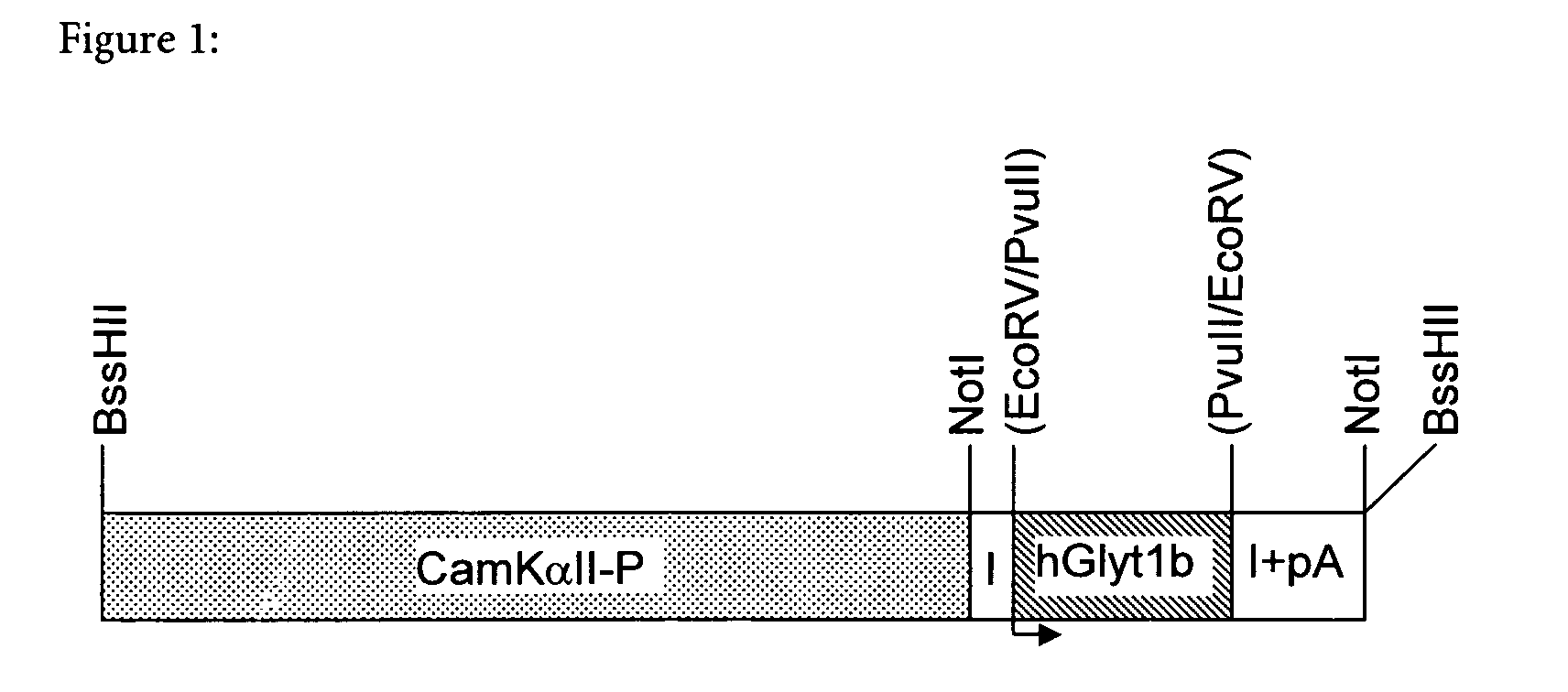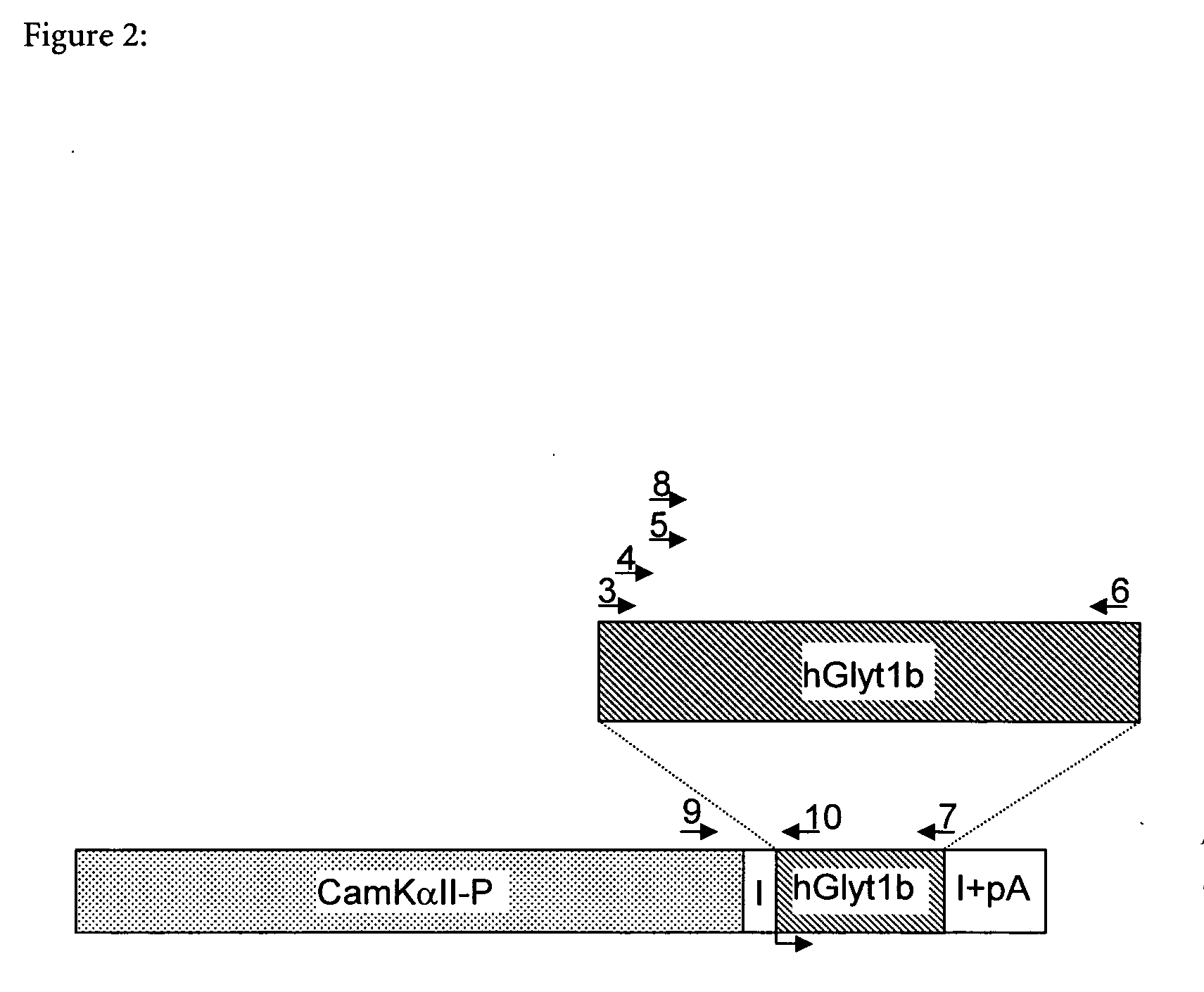GLYT1 transgenic mouse
- Summary
- Abstract
- Description
- Claims
- Application Information
AI Technical Summary
Benefits of technology
Problems solved by technology
Method used
Image
Examples
example 1
Generation of Mice
[0069] A) Cloning of human GLYT1b cDNA:
[0070] Based on sequence information from the published human glyt1b-cDNA-sequence (note: the GLYT1b—sequence is published as sequence of 1c; SEQ. ID NO: 1) primers (SEQ. ID NOs: 3 to 6)) were derived for cloning of the glyt1b-cDNA from a pACT2-cDNA library of whole human brain (Clontech) by a nested PCR. The amplified cDNA was subcloned into the NheI and EcoRI restriction-sites of the cloning vector pCI (Promega; SEQ. ID NO: 10).
[0071] B) Cloning of hGlyt1b-transgene:
[0072] The human glyt1b cDNA was reamplified from the above vector using the primers huGlyt1b-2147FLAG-PvuII-rev (SEQ. ID NO: 7) and huGlyt1b-234c (SEQ. ID NO: 8). The amplicon was cut with PvuII, purified and cloned into the EcoRV-site of the vector pNN265 (M. Mayford, E. Kandel, Columbia University, New York, USA; Choi, T., et al., Mol Cell Biol, 1991. 11(6): p. 3070-4) for the addition of introns and a polyA-sequence resulting in the vector pNN265-hGlyt1b-...
example 2
Molecular Analysis of GLYT1b Transgenic Mice
A) Histological Analysis of GLYT1b Mutant Mice
[0076] The overexpression of GLYT1b in the brains of mutant mice was confirmed by immunohistochemistry and by Western blot analysis using the GLYT1-specific antibodies raised in rabbits and guinea pigs.
[0077] B) Electrophysiological Analysis of GLYT1b Mutant Mice
[0078] NMDA receptor activation is required for induction of certain forms of long term potentiation (LTP) (Bliss, T. V. and G. L. Collingridge, Nature, 1993. 361(6407): p. 31-9). Potentiation induced by theta burst stimulation in hippocampal slices of GLYT1b-transgenics was compared with wild-type controls throughout the post-tetanus period as described previously (Kew, J. N., et al., J Neurosci, 2000. 20(11): p. 4037-49). It was determined whether GLYT1b-transgenic mice exhibit a different level of LTP-potentiation compared to wild-type controls.
[0079] C) Preparation of Forebrain and Brainstem Synaptosomes
[0080] Mice were sacri...
example 3
Behavioral Analysis of GLYT1 Mutant Mice
[0087] A) Neurological Assessment
[0088] Neurological assessment includes a number of neurological tests like flexion reflex, grip strength (g) and time (sec) spent on a rotarod at 16 and 32 rpm and body weight.
[0089] B) Spontaneous Behavior
[0090] The GLYT1b transgenic mice were observed for signs of natural exploratory behavior including body posture, gait and sensory responses (Irwin, S., Psychopharmacologia, 1968. 13(3): p. 222-57). In addition, their spontaneous locomotor activity was analyzed (activity box). Moreover, the state of anxiety was assessed by exposing to the animals to naturally aversive stimuli (elevated plus maze test and the light / dark choice test).
[0091] C) Auditory Startle and Prepulse Inhibition of the Acoustic Startle Reflex (Behavior Related to Schizophrenia)
[0092] Testing was conducted in eight startle devices each consisting of a Plexiglas cylinder (5 cm in diameter) mounted on a Plexiglas platform in a ventilat...
PUM
| Property | Measurement | Unit |
|---|---|---|
| Plasticity | aaaaa | aaaaa |
Abstract
Description
Claims
Application Information
 Login to View More
Login to View More - R&D
- Intellectual Property
- Life Sciences
- Materials
- Tech Scout
- Unparalleled Data Quality
- Higher Quality Content
- 60% Fewer Hallucinations
Browse by: Latest US Patents, China's latest patents, Technical Efficacy Thesaurus, Application Domain, Technology Topic, Popular Technical Reports.
© 2025 PatSnap. All rights reserved.Legal|Privacy policy|Modern Slavery Act Transparency Statement|Sitemap|About US| Contact US: help@patsnap.com



